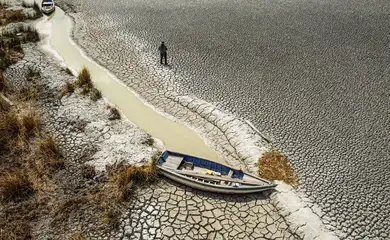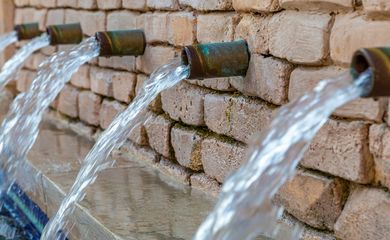Guarani Aquifer: water stock replenishment is insufficient

A research conducted by the Institute of Geosciences at São Paulo State University (Unesp) in Rio Claro has revealed that the Guarani Aquifer's water replenishment is insufficient to sustain its current levels. This aquifer spans parts of southern and southeastern Brazil, as well as Paraguay, Uruguay, and Argentina, serving 90 million people. It plays a crucial role in maintaining the levels of rivers and lakes in parts of São Paulo state during the dry season.

In an interview with Agência Brasil, researcher Didier Gastmans, from the Center for Environmental Studies at Unesp Rio Claro, explained that the research sought to understand the importance of rainfall in the entry of new water into the aquifer, in the outcrop areas (surface), and that it was possible to confirm this role. He has been following the subject since 2002, during his doctorate, and all the research since then has shown that the effects of overexploitation of the reservoir are constant, continuous, and have worsened with the change in the distribution of rainfall in the outcrop area, which feeds the aquifer. The problem is causing concern in areas with a large agricultural production and population, such as Ribeirão Preto, in the north of the state of São Paulo, where the first effects have been felt since the 1990s. “Now the number of wells has started to increase a lot and this is beginning to show signs of stress in various regions of the state,” said Gastmans.
The geologist noted that signs of overexploitation are evident in the monitoring of wells and reservoir levels, affecting areas near the outcrop regions, where water levels are typically two to three meters lower on average. This issue also impacts large industrial and agribusiness wells, where the decline in water levels can reach averages of 60 to 70 meters over ten years. “As the water level drops in the wells, it requires deeper drilling and more powerful pumps. In the western region of São Paulo, we're dealing with large producers and public supply systems, while small producers in areas near the outcrop are already experiencing these effects,” he explained.
The decline in water levels at certain points reaches up to 100 meters, which is significant given that the Guarani Aquifer has a thickness of 450 meters and can extend to depths of up to 1 kilometer. The majority of water drawn from the aquifer is used for urban supply, with at least 80 percent concentrated in the state of São Paulo.
One of the short-term concerns is that rainfall in the surface regions, which recharge the aquifer, is highly concentrated. This results in a small portion of the rainfall infiltrating the subsoil, leading to increased runoff. Additionally, rising average temperatures in these areas are exacerbating evaporation rates.
Monitoring
Gastmans criticized public bodies for lacking a clear action plan, stating that the first step is to identify the users of water resources. “We need to establish a near real-time monitoring system to assess services and inform short- and medium-term policies,” he said. The second step involves integrating groundwater and surface water management to optimize usage based on seasonal availability.
“We must also prioritize future planning. While we often discuss development, managers seem to overlook that true sustainability is unattainable; every development project has its impacts. It’s crucial for them to start anticipating potential problems,” Gastmans added.
The Unesp researcher also emphasized the importance of prioritizing higher quality water for public supply while reserving lower quality water for other uses, such as irrigating large sugar and citrus plantations and for industrial applications.
The São Paulo State Water Agency (SP Águas) informed Agência Brasil that it monitors all studies related to the recharge of the Guarani Aquifer and other water bodies in the state. The agency stated, “The management of the aquifer is conducted in an integrated manner with other water resources to ensure a balance between usage demands and environmental preservation.”
Most water extraction in the state of São Paulo comes from surface sources, such as rivers and lakes, while deep wells tapping into the Guarani Aquifer account for a small portion of the total water resources. “All water extraction in the state requires a permit, which is granted only after thorough technical analysis,” he noted.
Origin of the water
The research conducted by Unesp, supported by Fapesp, São Paulo's research agency, utilized stable isotopes of hydrogen and oxygen to trace the origins of the waters that replenish the Guarani Aquifer. This approach helped identify the surface areas contributing to the aquifer's water levels. Additionally, they employed isotopes of krypton and helium to date water samples from various wells, revealing ages ranging from 2,600 years in Pederneiras to 127,000 years in Bebedouro, 230,000 years in Ribeirão Preto, and 720,000 years in Paraná.
Dê sua opinião sobre a qualidade do conteúdo que você acessou.
Escolha sua manifestação em apenas um clique.
Você será direcionado(a) para o sistema Fala.BR, mas é com a EBC que estará dialogando. O Fala.BR é uma plataforma de comunicação da sociedade com a administração pública, por meio das Ouvidorias.
Sua opinião ajuda a EBC a melhorar os serviços e conteúdos ofertados ao cidadão. Por isso, não se esqueça de incluir na sua mensagem o link do conteúdo alvo de sua manifestação.
Clique aqui para mais informações sobre a Ouvidoria da EBC.










